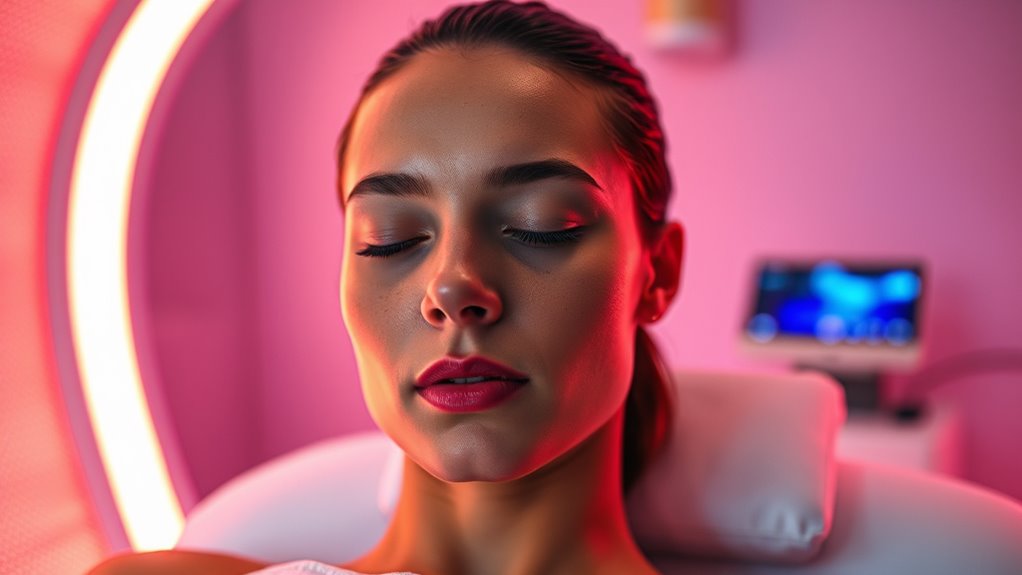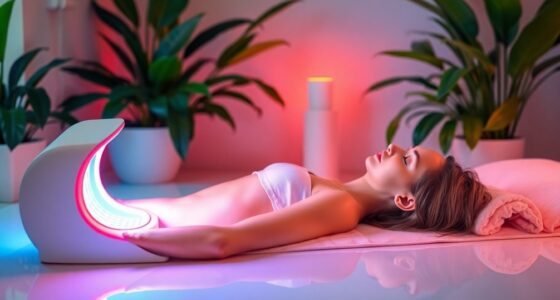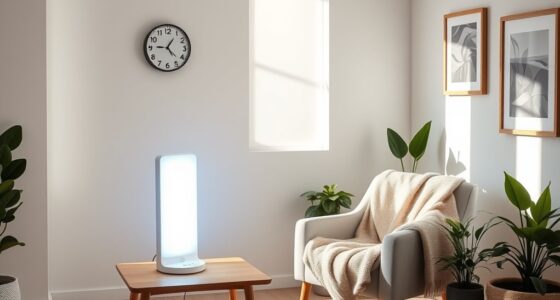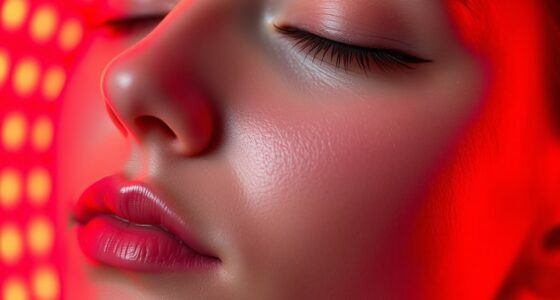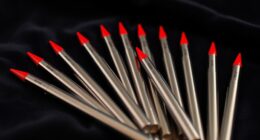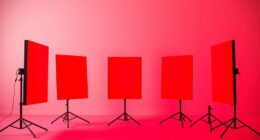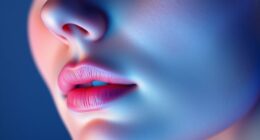To boost your skin recovery as an athlete, incorporate light therapy sessions into your post-workout routine. Use devices with specific wavelengths to promote cellular activity, reduce inflammation, and accelerate tissue repair. Consistency and proper application are key to maximizing benefits like improved skin resilience and faster healing. Tracking your progress with data can help optimize your routine. Keep exploring to discover how to get the most out of this natural, non-invasive recovery tool.
Key Takeaways
- Incorporate light therapy sessions into your post-workout routine, aiming for 10-20 minutes to enhance skin healing.
- Use devices with appropriate wavelengths designed for skin treatment to maximize recovery benefits.
- Regularly track progress with data analytics to optimize treatment duration and frequency.
- Combine light therapy with proper nutrition and hydration for faster tissue repair and skin resilience.
- Consult healthcare professionals to develop personalized routines and ensure safe, effective skin recovery practices.
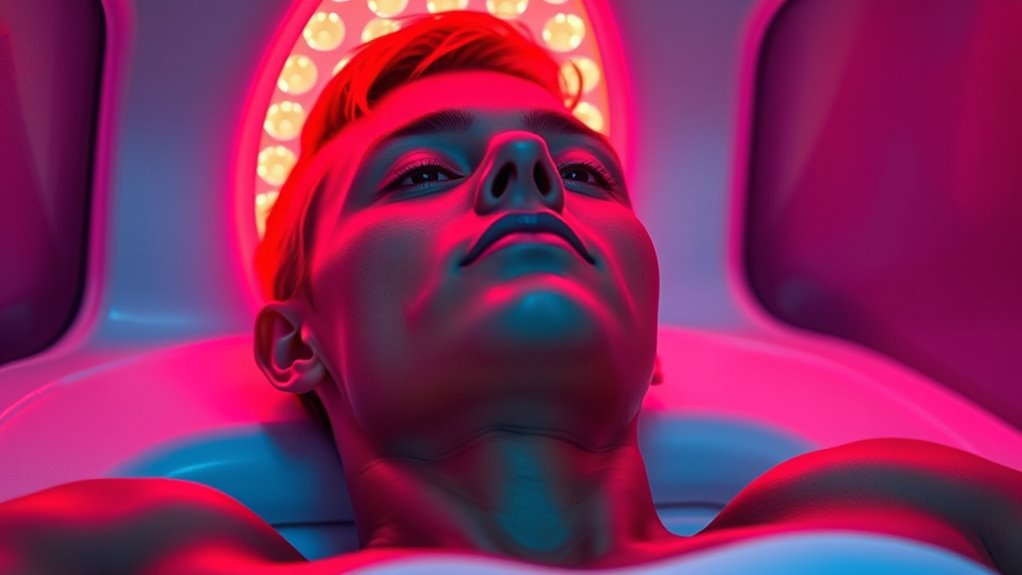
Light therapy is gaining popularity among athletes as a natural way to enhance recovery and improve performance. It’s a simple, non-invasive method that uses specific wavelengths of light to stimulate cellular activity, helping your skin heal faster after intense workouts or injuries. When you incorporate light therapy into your routine, you may notice reduced inflammation, less soreness, and quicker tissue repair, all of which contribute to a more efficient recovery process.
One of the main benefits of light therapy for skin recovery is its ability to promote increased blood flow. As you expose your skin to targeted light, blood vessels expand, delivering more oxygen and nutrients to damaged tissues. This accelerates the healing process and reduces the time your skin needs to recover from cuts, abrasions, or bruises. Plus, improved circulation helps flush out toxins and waste products that can hinder healing. As a result, your skin looks healthier and recovers more quickly after demanding physical activities.
Light therapy also stimulates the production of collagen, a crucial protein that supports skin elasticity and strength. Regular sessions can help reduce the appearance of scars, fine lines, and skin discoloration caused by injury or repeated strain. If you’ve been dealing with persistent skin issues from training, such as hyperpigmentation or rough patches, light therapy offers a natural way to boost your skin’s resilience and restore its smooth, healthy appearance.
Moreover, light therapy can modulate inflammation, which is a common response to intense training or injury. Instead of relying solely on medications or topical creams, you can use light therapy to reduce swelling and soreness at the source. By calming inflammatory responses, you minimize tissue damage and discomfort, enabling you to get back to training sooner. This makes light therapy especially appealing for athletes who need to maintain a rigorous schedule without lengthy downtimes.
Additionally, incorporating data analytics can help tailor your light therapy routine by tracking your progress and optimizing treatment parameters for better results. To maximize the skin recovery benefits, it’s important to follow a consistent routine. Many athletes incorporate light therapy sessions into their post-workout recovery, usually lasting about 10-20 minutes. You should use devices designed for skin treatment, ensuring the wavelength aligns with therapeutic goals. Always follow manufacturer instructions and consider consulting a healthcare professional to tailor the approach to your specific needs. When used correctly, light therapy becomes a powerful tool to support your skin’s healing process, helping you recover faster, look better, and perform at your best.
Frequently Asked Questions
Can Light Therapy Prevent Future Athletic Injuries?
Light therapy can help prevent future athletic injuries by promoting faster healing and reducing inflammation. When you use it consistently, it boosts circulation and stimulates cell repair, which strengthens your tissues over time. This proactive approach keeps your muscles and joints healthier and more resilient. While it’s not a guaranteed injury shield, incorporating light therapy into your routine can considerably lower your risk of future setbacks and enhance your overall performance.
How Often Should Athletes Use Light Therapy Sessions?
You should use light therapy sessions about 3 to 5 times a week, depending on your specific needs and recovery goals. Consistency is key, so stick to a regular schedule to maximize benefits. Always follow your healthcare provider’s recommendations, as they’ll tailor the frequency based on your injury severity and response to treatment. Avoid overdoing it to prevent skin irritation or diminishing returns.
Are There Any Side Effects From Prolonged Light Therapy Use?
Prolonged light therapy can cause side effects like skin irritation, redness, or eye strain if you’re not careful. You might also experience headaches or fatigue from overuse. To avoid these issues, follow recommended session durations and frequencies, and always wear protective eyewear if advised. If you notice any adverse effects, stop using the therapy and consult a healthcare professional for guidance.
Is Light Therapy Effective for All Skin Types and Tones?
Light therapy is generally effective across all skin types and tones, but individual responses can vary. You might find it more beneficial if your skin reacts well to light treatments. Darker skin tones may require adjustments to avoid hyperpigmentation, so consulting a dermatologist is wise. Overall, consistent use can improve skin recovery, but tailoring the approach to your specific skin type guarantees the best results and minimizes potential risks.
What Equipment Is Recommended for At-Home Light Therapy Treatments?
You should choose a reputable LED light panel or mask designed for at-home use. Research shows that over 80% of users report visible skin improvements within four weeks. Look for devices with adjustable settings, specific wavelengths (red and near-infrared), and safety certifications. Brands like Joovv, Dermashine, and MZ Skin offer reliable options. Always read instructions carefully, and consider consulting a dermatologist to guarantee the device suits your skin type and goals.
Conclusion
Think of light therapy as your personal lighthouse guiding your skin back to health after intense training. By embracing this simple yet powerful tool, you’re steering your recovery ship through the stormy seas of soreness and fatigue. Remember, consistency is your compass, and patience is your steady anchor. With each session, you’re illuminating your path to faster healing and stronger skin, making your comeback smoother and brighter than ever before.
